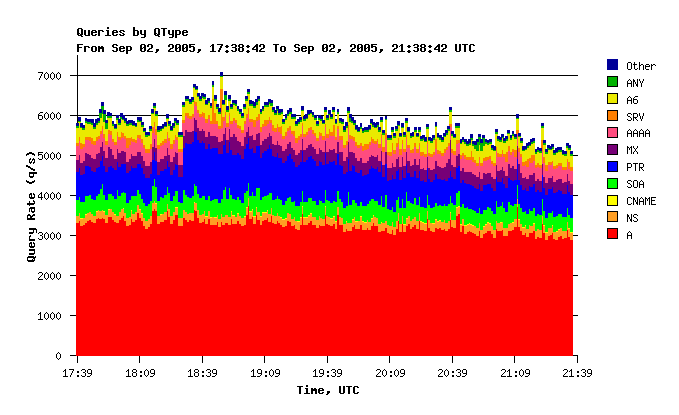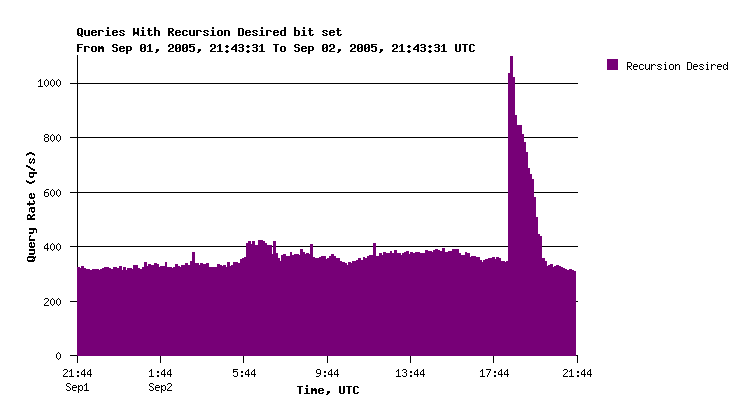
To begin, Birger saw the OSMC 2011 kick off, with an opening speech by Bernd where our new performance grapher, InGraph was also introduced. He then went off to Christoph Siess’ presentation, which gave a “Performance Comparison of Nagios Monitoring Solutions” (read Nagios, Icinga, Shinken, mod_gearman, Merlin). In short, he noted latency dramatically increases in Nagios 3.2.1 once a certain number of checks is exceeded. Nagios with mod_gearman and Shinken perform significantly better, while latency in Nagios, Icinga and Merlin were similar.
Ronny followed with a tool for statistical analysis of DNS servers. The DSC (DNS Statistics Collector) runs a collector on the server to record traffic flows in the form of a XML file every 60 seconds. This file is then converted by a presenter component for display in a CGI web interface. More information is available on the developer’s homepage.
Bernd then offered his impressions of the second OSMC day. After a big night atop the Nuremberg Christmas Market, almost all attendees made it to the conference rooms for two tracks of presentations on Nagios, Icinga with their related plugins and addons.
In between, Carsten offered an alternative to NSClient++ for windows monitoring – check_wmi_plus. As a plugin, check_wmi_plus offers agentless monitoring of a similar standard, implementing checks with performance data too. He noted that installation requires the WMI client for Linux, and gave some tips for configuring users and service monitoring in the command line with SubInACL. Documentation with more on useful checks is also within reach.
Also, Johannes shared a Python module for Windows Vista’s UAC, which he ported based on a suggested solution made by Aaron Margosis in his blog. Humbler.py resolves a problem similar to the LUA bug, where the user settings are at odds with the registered user.
Finally Pamela bid the OSMC 2011 farewell, thanking all participants, supporters and the Holiday Inn hotel for their contributions to a great event. She shared Jens-Christopf Brendel’s review in Admin Magazin and has since been busy filling the attendee area of the OSMC website with photos and presentation slides from the conference. The date for the next OSMC has been set for 17 – 18 October 2012, but before then, we hope to see you at our next event – the Open Source Data Center Conference on 25 – 26 April!
NETWAYS Blog
Statistikauswertung eines DNS Server
Wer kontrollieren möchte, was seine DNS Server so den lieben langen Tag alles über machen und welche Anfragen hereinkommen, kann sich hier mit dem Tool DSC (DNS STATISTICS COLLECTOR) behelfen. Das Setup und die Möglichkeiten dabei reichen von einzelnen Kontrollen bis hin zur Überwachung größere Servermengen auf zentralen Stationen.
Damit dies möglich ist, gliedert sich die Auswertung in 2 Routinen. Als erstes gibt es den Collector, welcher auf den Nameservern selbst läuft und den Verkehr mitlauscht. Dieser schreibt dann anhand von definierten Regeln z.B. alle 60 Sekunden eine Auswertung in Form eines XML Files heraus. Und dieses XML File wird dann wiederum im zweiten Schritt vom Presenter zur Darstellung verwendet. Die Ablage der XML Files kann lokal oder auf einer zentralen Station erfolgen – und für die Übertragung zu einem gesammelten Punkt bringt das Tool auch verschieden Beispiele mit, bevorzugt wird dabei eine Variante mittels Webserver und SSL-Authentifizierung des Servers und der Clients.
Wenn die Überwachung mit dem Collector und die Auswertung mit dem Presenter fertig eingerichtet ist, kann man sich die Daten dann grafisch darstellen lassen. Eine komplette Aufstellung von Beispielen gibt es auf der Homepage der Entwickler zu sehen. Anbei nur ein paar Auszüge.


















